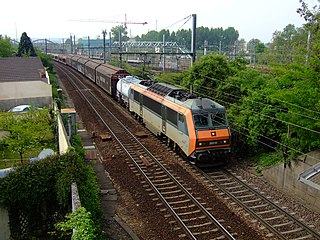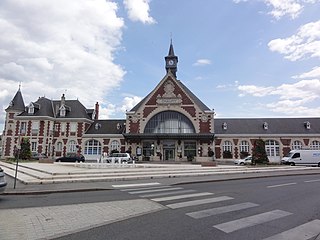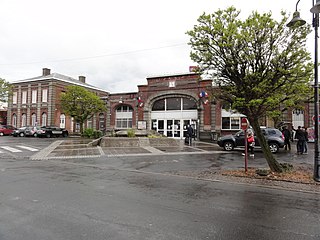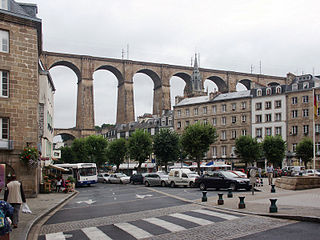
The Gare du Nord, officially Paris Nord, is one of the seven large mainline railway station termini in Paris, France. The station is served by trains that run between the capital and northern France via the Paris–Lille railway, as well as to international destinations in Belgium, Germany, the Netherlands and the United Kingdom. Located in the northern part of Paris near the Gare de l'Est in the 10th arrondissement, the Gare du Nord offers connections with several urban transport lines, including Paris Métro, RER and buses. It is the busiest railway station in Europe by total passenger numbers, and the busiest outside Japan. In 2015, the Gare du Nord saw more than 700,000 passengers per day.
The Chemins de fer du Nord, often referred to simply as the Nord company, was a rail transport company founded in September 1845 in Paris. It was owned by, among others, de Rothschild Frères of France, N M Rothschild & Sons of London, Charles Laffitte and Edward Blount, and Baron Jean–Henri Hottinguer. Baron James de Rothschild served as the company's president from its inception until his death in 1868.

The Grande Ceinture line is a railway line around Paris, located 15 kilometres (9.3 mi) from the Boulevard Périphérique. The decision to build it was taken at the end of the 19th century, to connect the radial lines linking the capital to the provinces and provide relief to the busy Petite Ceinture Line.

Épinay - Villetaneuse is a railway station located in the commune of Épinay-sur-Seine, Seine-Saint-Denis department, France. It is also adjacent to the communes of Montmagny and Deuil-la-Barre in Val d'Oise.

The Persan–Beaumont station is a railway station in Persan, France, near Beaumont-sur-Oise. It is at the junction of the Épinay-Villetaneuse–Le Tréport-Mers railway and the Pierrelaye–Creil railway. The station is served by trains of the Transilien line H and the TER Hauts-de-France.

Valmondois is a railway station located in the commune of Butry-sur-Oise, France. The station is served by Transilien H trains Creil - Pontoise and Paris - Saint-Leu-la-Forêt - Persan-Beaumont. The daily number of passengers was between 500 and 2,500 in 2002.

Compiègne station is a railway station serving Compiègne, in the Oise department of northern France. The station is on the Creil–Jeumont railway. It is served by regional trains to Creil, Amiens, Saint-Quentin and Paris.

Chauny station is a railway station serving the town Chauny, Aisne department, northern France. It is situated on the Creil–Jeumont railway.

Aulnoye-Aymeries station is a railway station serving the town Aulnoye-Aymeries, Nord department in the Hauts-de-France region of France. It is situated on the Creil–Jeumont railway and the Fives–Hirson railway.

Maubeuge is a railway station serving the town Maubeuge, Nord department, northern France. It is situated on the Creil–Jeumont railway.

Montdidier is a railway station located in the commune of Montdidier in the Somme department, France.

The Paris–Lille railway is a 251-kilometre-long (156 mi) railway line, that connects the French capital, Paris, to the northern city of Lille. Branch lines offer connections to Belgium and Great Britain. Opened on 20 June 1846, it was one of the first railway lines in France. The opening of the parallel LGV Nord high speed line in 1993 has decreased its importance for long-distance passenger traffic.

The railway from Paris to Brest is a 622-kilometre long railway line in France that connects Paris and the western port city Brest, via Le Mans and Rennes. It is used for passenger and freight traffic.

The railway from Paris to Marseille is an 862-kilometre long railway line, that connects Paris to the southern port city of Marseille, France, via Dijon and Lyon. The railway was opened in several stages between 1847 and 1856, when the final section through Lyon was opened. The opening of the LGV Sud-Est high speed line from Paris to Lyon in 1981, the LGV Rhône-Alpes in 1992 and the LGV Méditerranée in 2001 has decreased its importance for passenger traffic.

The railway from Paris to Bordeaux is an important French 584-kilometre long railway line, that connects Paris to the southwestern port city Bordeaux via Orléans and Tours. The railway was opened in several stages between 1840 and 1853, when the section from Poitiers to Angoulême was finished. The opening of the LGV Atlantique high speed line from Paris to Tours in 1989 has decreased the importance of this section of the line for passenger traffic; the opening of the LGV Sud Europe Atlantique in 2017 has seen all long distance passenger trains migrating to that line and leaving space for more regional and local trains, as well as freight trains.

The railway from Paris-Est to Strasbourg-Ville is a 493-kilometre-long railway line that connects Paris to Strasbourg via Châlons-en-Champagne and Nancy, France. Officially, the line does not start at the Gare de l'Est in Paris: the first 9 km until Noisy-le-Sec is shared with the railway from Paris to Mulhouse. The railway was opened in several stages between 1849 and 1852. The opening of the LGV Est high speed line from Paris to Baudrecourt in Lorraine in 2007 has decreased the importance of the section Paris–Sarrebourg for passenger traffic.

The Longueau–Boulogne railway is a French railway which runs from a junction with the Paris-Lille railway at Longueau to the coastal port of Boulogne. A double track railway it is 171 kilometres long. Until the start of the Eurostar service from London to Paris in 1994 via LGV Nord it was the main route for the boat trains to Paris which met the ships carrying passengers from Great Britain. As of August 2011 the line is used by Intercités services from Paris to Boulogne, TGV services from Rang-du-Fliers via Calais-Fréthun to Lille-Europe and local TER Hauts-de-France services.
The Maubeuge-Fourmiesrail line was a French non-electrified, single track railway line, inaugurated August 29, 1885 between Maubeuge station and Fourmies. The line started as branch line for industrial use that was commissioned on October 29, 1860.

Villiers-le-Bel – Gonesse – Arnouville is a railway station in Arnouville, Essonne, Île-de-France, France. The station was opened in 1859 and is on the Paris–Lille railway. The station is served by the RER Line D, which is operated by SNCF. The station serves the communes of Arnouville, to the north Villiers-le-Bel and, to the east, Gonesse.

















